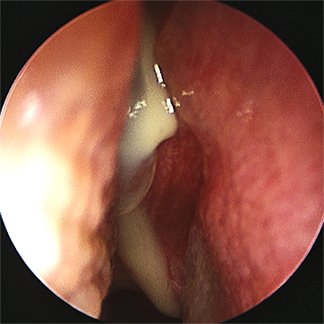Question of the Week - July
August 9th, 2023
A 57-year-old-woman presents to the clinic with facial pain, nasal congestion, and nasal drainage over the past 4 days. She denies rhinorrhea, cough, or sore throat. She also states she has been unable to smell over the past 24 hours. She has never experienced these symptoms before, and she has had reliable follow-up in the past. Her temperature is 37.9ºC, heart rate is 75 bpm, blood pressure is 128/84, and respiratory rate is 16/min. Physical exam reveals tenderness to palpation over the frontal sinuses. Endoscopic exam shows bilateral nasal mucosal edema and purulent nasal secretions, as shown in the Figure. What is the next best step in management?
A) CT scan of the head
B) MRI of the head
C) Systemic glucocorticoids
D) Systemic antifungal therapy
E) Symptomatic care with 1 week follow-up
-
Correct Answer: E
Explanation:
This patient’s symptoms are suggestive of acute rhinosinusitis, which may be bacterial or viral, and requires the presence of symptoms for <4 weeks. Because a substantial number of patients with clinically diagnosed acute rhinosinusitis improve with supportive care alone, symptomatic care is generally recommended with observation for patients who can reliably return for follow-up, though initial antibiotic therapy may also be used. Systemic glucocorticoids and antifungal therapy are not indicated in the treatment of acute rhinosinusitis. Imaging should not be obtained for patients with uncomplicated acute rhinosinusitis, unless a complication or alternative diagnosis is suspected.
References:
Rosenfeld RM, Piccirillo JF, Chandrasekhar SS, et al. Clinical practice guideline (update): adult sinusitis. Otolaryngol Head Neck Surg. 2015;152(2 Suppl):S1-S39. doi:10.1177/0194599815572097
Image Credit: UpToDate - Acute sinusitis and rhinosinusitis in adults clinical manifestations and diagnosis [Article Link]
